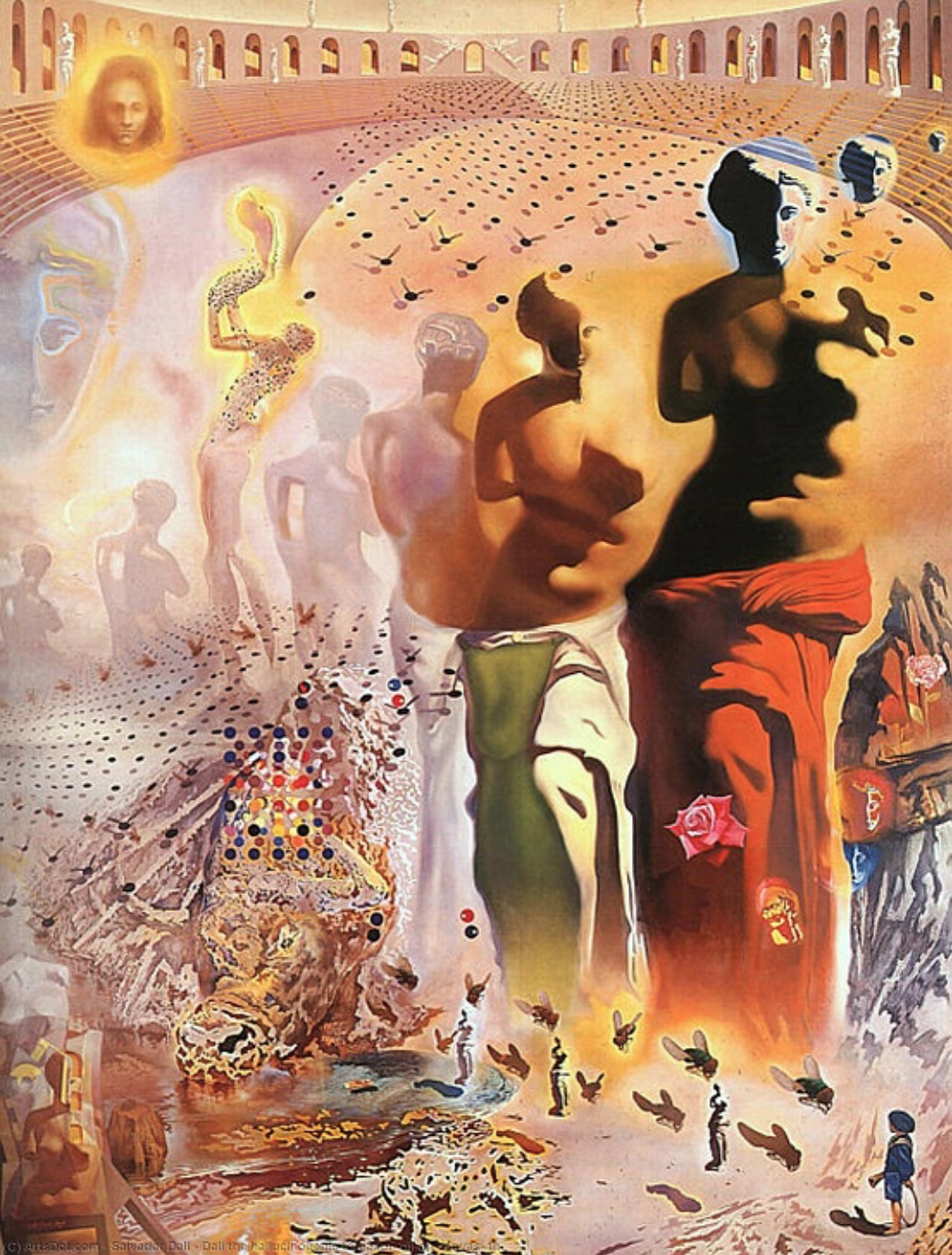
The Hallucinogenic Toreador presents a panorama of themes and symbols which have appeared in many of Dalí’s previous works. Painted in 1970, when the artist was 66 years old, the monumental work (measuring 4 by 3 meters) may be considered a culmination of his entire creative career
The scene takes place in a bullfighting arena, circumscribed on top by the coliseum arches and stands. An army of gadflies march in straight, parallel lines from the upper right to the lower left, leading to the head and horns of a dying bull. To the bull’s right are large Hellenistic statues of the Venus de Milos, an icon which Dalí has adopted in multiple paintings. Examined from a distance, the body of the Venus in green and white draperies reveals the face and chest of man: Her left breast doubles as his nose, her belly his chin, and her face transforms into his eye, from where drips a line of black tear. Her draperies make up his white shirt and green necktie. To the right, the silhouette of another Venus outlines the cheek of the man, while her draperies become a bullfighter’s red cape. The male image represents Manuel Laureano Sanchez, “The Manolete”, a toreador who rose to fame in the 1940s but was killed by Islero the bull in 1947, an event that shocked the bullfighting world. Dalí plays with illusion in this painting: The image of the semi-visible toreador fades in and out of the observer's perception
Another transformation of image and meaning is found below the bull’s head, where the pool of its blood and saliva morphs into a bay. On the water drifts a yellow raft with a human figure on top. A boy dressed in a sailor’s suit stands on the beach in the bottom right. He is said to represent Dalí as a youth. Above him soars a craggy peak with a rose near its summit. This recalls the precipitous mountains around the town of Rosas, Girona, near Dalí's studio. Concerned by the increase in tourism in his hometown, the youthful Dalí is summoning the gadflies of Saint Narcissus to drive away the tourists. (According to legend, in 1285, the people of Girona were saved from a French army siege by a swarm of flies emanating from Saint Narcissus’ tomb in the Collegiate Church of Sant Feliu)
In the upper left, diagonally across from the boy Dalí, appears the apparition of a woman’s head. She is Gala, Dalí's wife, whose deep-seated dislike for bullfighting is conveyed in her sour and disapproving expression. It is suggested that the placement in this painting of Dalí and his wife, separated by the longest distance possible, reflects their rocky relationship at the time this canvas was made. Gala, around 76 years old, was living in a castle in Púbol by herself and Dalí agreed not to visit there without getting advance permission from her in writing
Elsewhere in the painting are yet more symbols and motifs. A bust of Voltaire is seen on the red drapes of Venus; this recalls an earlier painting entitled Slave Market with the Disappearing Bust of Voltaire. The flower nearby refers to the tradition in Catalonia of people giving red roses to each other on the day of Sant Jordi (or Saint George), the patron saint of Catalonia. An artist's easel and a white Venus sculpture are depicted in the lower left, a linkage to Dalí's art-school experiences of drawing from plaster casts. The multi-coloured dots above the bull head reference the emerging op art movement of the late 1960s/early 1970s
As its name suggests, The Hallucinogenic Toreador seems to be a dream. The images blend together, what one sees at first glance transforms into something new upon a second look
- Dalí Theatre and Museum, Figueres, Catalonia
- Portlligat Museum-House, Catalonia
- Gala Dalí Castle Púbol, Girona, Catalonia
- Salvador Dalí Museum, St. Petersburg, Florida
